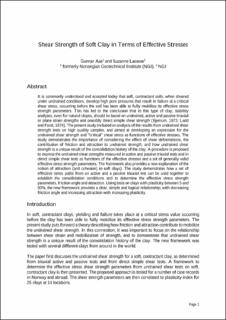| dc.description.abstract | It is commonly understood and accepted today that soft, contractant soils, when sheared under undrained conditions, develop high pore pressures that result in failure at a critical shear stress, occurring before the soil has been able to fully mobilize its effective stress strength parameters. This has led to the conclusion that in this type of clay, stability analyses, even for natural slopes, should be based on undrained, active and passive triaxial or plane strain strengths and possibly direct simple shear strength (Bjerrum, 1973; Ladd and Foott, 1974). The present study included an analysis of the results from undrained shear strength tests on high quality samples, and aimed at developing an expression for the undrained shear strength and "critical" shear stress as functions of effective stresses. The study demonstrates the importance of considering the effect of shear deformations, the contribution of friction and attraction to undrained strength, and how undrained shear strength is a unique result of the consolidation history of the clay. A procedure is proposed to express the undrained shear strengths measured in active and passive triaxial tests and in direct simple shear tests as functions of the effective stresses and a set of generally valid effective stress strength parameters. The framework also provides a new explanation of the notion of attraction (and cohesion) in soft clays). The study demonstrates how a set of effective stress paths from an active and a passive triaxial test can be used together to establish the consolidation conditions and to determine the effective stress strength parameters, friction angle and attraction. Using tests on clays with plasticity between 5 and 90%, the new framework provides a clear, simple and logical relationship, with decreasing friction angle and increasing attraction with increasing plasticity. | en_US |

